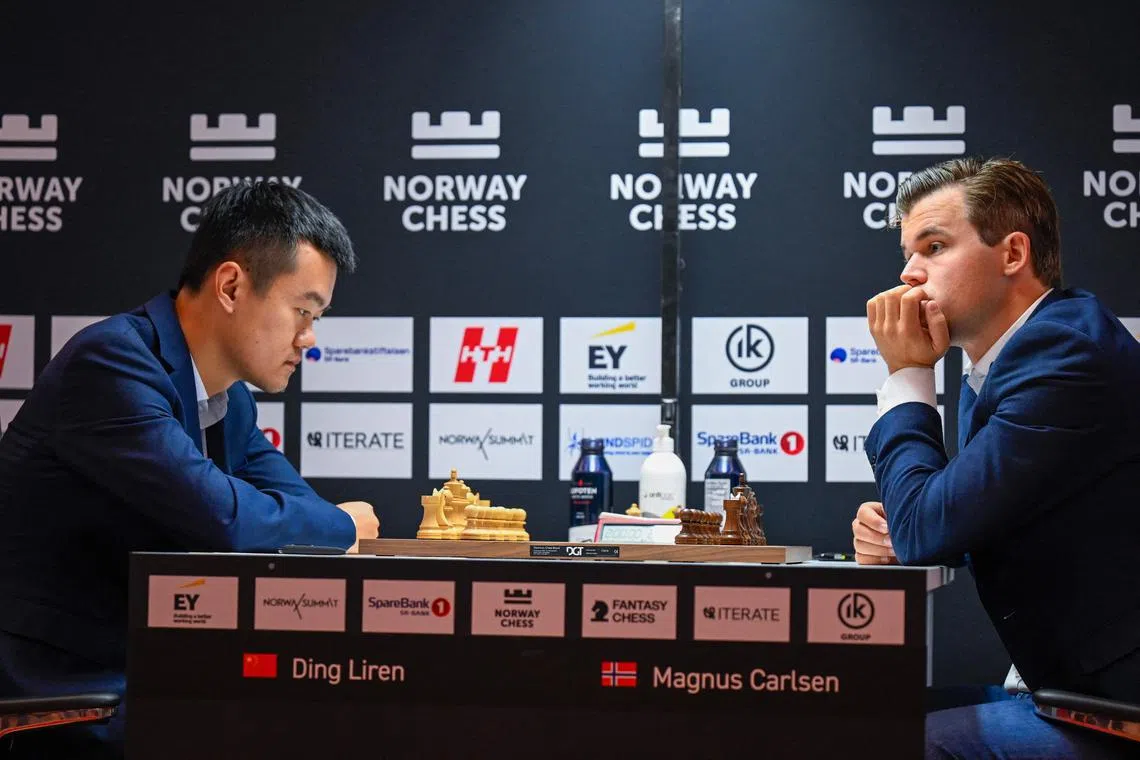Chess players wonder if being a grandmaster still has meaning
Sign up now: Get ST's newsletters delivered to your inbox

Chinese grandmaster Ding Liren playing against Norwegian grandmaster Magnus Carlsen during the Norway Chess 2024 in May.
PHOTO: AFP
Follow topic:
NEW YORK – When the International Chess Federation (Fide) created the inaugural list of grandmasters – the game’s highest title – in 1950, there were 27. Today there are more than 1,850.
“There are too many grandmasters,” said Nigel Short, director for chess development at the federation, who himself is a grandmaster.
Short, who is English, said that when he is in Germany, which has almost 100 grandmasters, “to call me grandmaster adds nothing”.
The 59-year-old pointed out that the high number of grandmasters is a relatively recent phenomenon. When he was a rising junior player in the late 1970s, there were only about 100 of them in the world.
To become one is technically not easy.
A player must at least once achieve an Elo rating – the system used to rank players – of more than 2,500; less than 1 per cent of players ever do that. A player must also achieve a “norm”, a performance equivalent to playing at the level of a player rated 2,600, in at least three tournaments.
But not all grandmasters are created equal.
Magnus Carlsen, the former world champion, who has been ranked No. 1 in the world almost continuously since 2009, is one. So is Jacob Aagaard, a coach and trainer. The difference between them is their ratings – Carlsen’s is 2,830, while Aagaard’s is 2,426.
Aagaard explained that he stopped playing professionally 15 years ago, shortly after he became a grandmaster.
Though the 50-year-old still competes occasionally, he plays more for enjoyment.
Grandmaster titles are for life. Even not playing does not lead a player to lose the title.
Among the 1,850 or so grandmasters, only about 1,400 play in official rated competitions at least once a year, and some have not played in decades.
The fact that Carlsen and a player like Aagaard are grandmasters can be “confusing”, said Fabiano Caruana, a three-time US champion ranked No. 2 in the world, with a rating of 2,805.
He added that he thinks ratings are sufficient for distinguishing among players’ ability and regards the grandmaster titles as kind of “lifetime achievement recognition awards”.
But Emil Sutovsky, Fide chief executive officer, who is also a grandmaster, said he sees no need to change the grandmaster system.
The 46-year-old, who was ranked as high as No. 17 in the world but who now sits at No. 215, admitted that he once shared Short’s view.
“I thought it was a bit unfair that I belonged to the same category as players who were much weaker than me,” he said.
But he has changed his mind.
Though about 50 players earn the grandmaster title each year, Sutovsky noted that the number of players rated by the federation had grown rapidly in recent years and so, as a proportion of the number of players, the number of grandmasters has actually fallen.
“People who understand chess understand that ratings are more important,” he said.
To better distinguish the skill levels of grandmasters, fans have long adopted the informal designation of “super grandmaster” to refer to elite players, generally the 40 or so who are rated above 2,700.
Short dislikes such designations, calling them artificial.
“Next they’ll be calling the best players super intergalactic grandmasters,” he said.
Yasser Seirawan, 64, a four-time US champion who became a grandmaster in 1980, is also not a fan of creating another designation for the top players.
“The problem is that the title itself, ‘grandmaster’, is so dosh-gone elegant that tinkering with it by saying, ‘super grandmasters’, for example, feels like a fail,” he wrote.
At the same time, he agrees that lumping all grandmasters together is a problem, and thinks there should be a distinction for the top 10 in the world.
While there is no perfect solution, stripping the “grandmaster” title from players who no longer fulfil the initial criteria is not an option either, Sutovsky said.
“You cannot take the title away from someone who has completed the requirements,” he said.
“It would be detrimental for them. For many players, becoming a grandmaster is the ultimate goal.” NYTIMES

